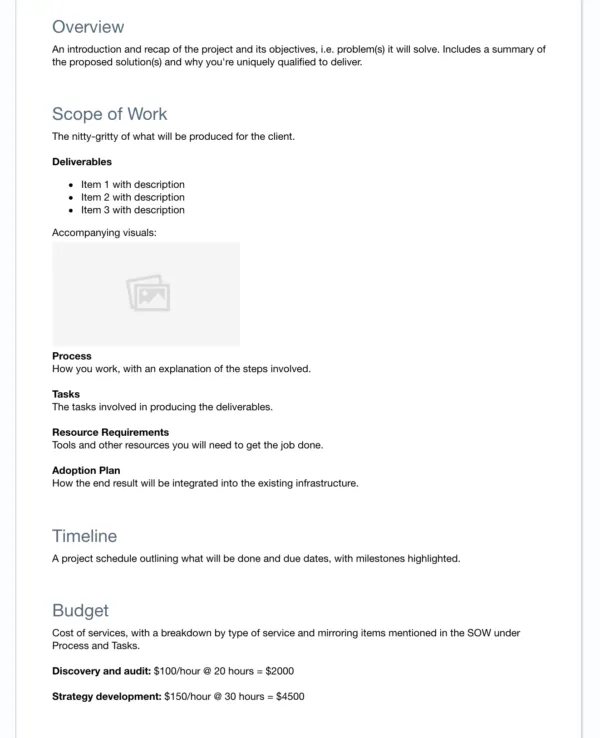How to perfect your proposals so they stand out from the crowd, and get approved faster.

When I first started my freelance content marketing business, my project proposal was something I casually sent over email. It didn’t take long to realize that I needed a more sophisticated proposal and process to scale my business.
But despite having the basics down, I still felt that I wasn’t closing as many clients as I’d like.
It wasn’t until one of my mentors taught me the importance of a project proposal (or business proposal) that reinforced my value, and then helped me develop a project proposal template to follow that I started seeing an increase in the rate of proposals accepted.
- 4 Key Reasons Your Proposals Are Getting Rejected
- Reason #1: You Haven’t Matched Your Skills to the Client’s Needs
- Reason #2: Your Proposals Look Unprofessional
- Reason #3: Your Proposals Are Too Long
- Reason #4: You Talk About Yourself Too Much
- 8 Ways to Add Wow Factor to Your Proposals
- 1. Interview Prospects
- 2. Highlight Client Benefits Front and Center
- Questions to Ask Before Writing Project Proposals
- 3. Include Testimonials
- 4. Allow Immediate Online Approval and Signature
- 5. Establish a Communications Workflow
- 6. Develop a Project Proposal Template
- 7. Present It Well
- 8. Measure Performance
- Commonly Overlooked Must-Haves for Your Proposals
- Deadlines
- Budget
- Adoption Plan
- Do You Always Need a Project Proposal?
- Winning More Business With Project Proposals
4 Key Reasons Your Proposals Are Getting Rejected
Before we go any further, let’s quickly review some reasons why your project proposal (and its process) is failing:
Reason #1: You Haven’t Matched Your Skills to the Client’s Needs
If the client can’t connect the dots between the project requirements and the value you bring, at best you’ll leave them confused. At worst, you’ll seem expensive or they’ll feel you’ve completely wasted their time.
I’ve experienced this from the client perspective, and it’s discouraging to say the least. I had spoken with a web developer to help me with a website redesign. In our initial conversation, we went into detail on every aspect needed for the project.
Then I received the proposal. It included many items that were never discussed—far beyond the scope of what was originally proposed—resulting in an estimate that was way over budget and leaving me feeling annoyed.
The lesson? Don’t show your client everything you can do in a proposal. Show them everything you can do for them to reach their objectives for this particular project—within the project budget and timeframe.
Reason #2: Your Proposals Look Unprofessional
The little details matter, such as logos and mailing addresses. Not only do professional proposals look appealing on the surface, but they also provide insight into the quality of work you provide.
If you provide a proposal that is hard to follow and is disorganized or missing key information related to the project, you’re making it difficult for the client to trust your business and that you understand the needs of the project.
Not to mention, the client is likely having conversations with other freelancers. Professionally presenting yourself, even in your documents, can be the deciding factor in getting your proposal approved.
Reason #3: Your Proposals Are Too Long
How long should a good project proposal be? As long as it takes to present the value proposition for your product or service. And not any longer.
There’s no hard and fast rule, for good reason. A proposal for a prospective client, for example, should include some information about your business, your approach, and why you’re a good fit for this project. You know, sell yourself.
For repeat clients, you can get right to the nitty-gritty about the scope of work, pricing, and timelines.
If the project is a longer, more involved one, the proposal should reflect that to some degree. The more money that’s on the line, the more the client is going to want to be assured you’re the right choice.
Although length is variable, it’s safe to say that no one is going to read a 40-page proposal. No matter what type of proposal you’re submitting, make it as clear and concise as possible. (Not a writer? Try Grammarly or a similar tool.)
Reason #4: You Talk About Yourself Too Much
Not putting the client’s needs first is an instant turnoff. An effective project proposal is focused on what the client needs and how you will deliver that.
Remember, the client is making an investment in the project and wants to ensure they will see the expected returns. That will be hard to envision if you’re failing to address the client’s needs, and instead, just talking about yourself.
The good news is that these problems can be fixed. On to the solutions!
8 Ways to Add Wow Factor to Your Proposals
Anyone who invests the time and is motivated to win more business can create a winning project proposal. Here are 8 ways to do that.
1. Interview Prospects
The single most crucial ingredient for creating a good project proposal is understanding the client and their problems. The best way to discover this information is through interviews.
It may seem unnecessary to jump on a call with a prospect; however, not only will it help qualify the potential client, but it also adds to building a solid client relationship. Clients appreciate and will note this extra step. In my personal experience, I find this a necessity in order to write a strong proposal, and it also strengthens the relationship between myself and the prospect.
2. Highlight Client Benefits Front and Center
No one likes reading a features list. They want to hear about the benefits and deliverables. The same goes when drafting a project proposal—clients want to hear how your work will benefit them rather than a list of duties you’ll complete. This is where doing your homework sets you apart.
Make sure you’ve answered the following questions before you begin writing your project proposal:
Questions to Ask Before Writing Project Proposals
- What Is the client’s core problem, and have I addressed it? It is crucial to connect your services and packages to your client’s needs—making it clear that you understand their pain points and can provide results.
- Who are the project’s stakeholders? Identifying the key stakeholders allows you to address each of their different needs in the documents—a perfect opportunity to stand out from the competition.
- What is the timeline for the project? Communicating how and when each stage of the project will be completed shows the prospect that you’re organized and timely—a great way to showcase your professionalism and value.
How you present the information collected from these questions is critical when it comes to putting the spotlight on the client benefits. Something to avoid is going straight into the scope of the work. Remember, this is a sales document and you’ll need to drive home the benefits of working with you until the project is accepted.
Start your proposal by restating the problem, highlighting how you’ll alleviate the problem, and exactly how the client will benefit from your work. Then it’s appropriate to present the tasks you’ll complete in order to achieve the results.
Here is a FreshBooks template that’s structured with all the necessary project proposal elements, organized in a way to put client benefits front and center:
3. Include Testimonials
Testimonials from past clients are a great way to reinforce the value you bring to the project. In fact, BigCommerce found that 92% of customers read online reviews before buying, and 72% of consumers say positive testimonials and reviews increase their trust in a business.
If possible, showcase testimonials from projects similar to this one, or from clients within the same industry. Does asking for testimonials sound intimidating or pushy? Here are some “non-icky” ways to get testimonials.
4. Allow Immediate Online Approval and Signature
Capitalize on the momentum of your prospect’s journey and allow them to sign the proposal right away. It makes your proposal look even more professional and it saves time for you and the client. It also prevents headaches later if there is any miscommunication about the initial agreement.
FreshBooks’ Proposal capabilities provide online approval and e-signatures and they convert approved proposals into invoices with a single click. Because proposals + immediate invoicing = more revenue.
5. Establish a Communications Workflow
Before you even send the project proposal, ask yourself, How will I collaborate with clients and team members if the proposal is accepted?
Once a project proposal is accepted, there are many moving parts that must be tracked, such as invoicing, expenses, and billable hours. You’ll impress clients if you can move quickly and efficiently while keeping all stakeholders in the loop.
Team collaboration software can help, ensuring no deadlines and billable hours are missed. FreshBooks allows you to convert your Proposal into a Project, where you can invite clients to discuss or give feedback, and you and your team can see every invoice, expense, and document related to the project.
6. Develop a Project Proposal Template
A project proposal template is “invisible work” that the client doesn’t see, so it’s tempting to skip it. But developing a template for your proposals ensures consistency, reduces errors, and allows you to create and submit proposals faster. And once you’ve got your project proposal template set, you can easily hand off some proposal work to your project team.
Since you’ll want to iterate on your project proposal over time, you can start A/B testing proposals by tweaking your template here and there to see which one wins more business.
7. Present It Well
Once you’ve finished writing the project proposal, the icing on the cake is to present it well to the client. This can be done in a couple of ways, depending on how you’d like to run your business.
Sending your proposal via email is a given, especially if that has been the primary channel of communication. But to take it to the next level, you might create a slideshow or short shareable video using a tool like Loom to walk new clients through your proposal.
One of my colleagues swears by presenting proposals directly to the client—by phone, video, or in-person—and says she gets more business this way.
Going this route definitely shows that you’ve gone the extra mile. It makes you more memorable and is a great option for complex projects. It also gives you the opportunity to answer any questions and address doubts immediately.
Follow up with an official request email that includes a brief overview, the proposal document, and a copy of the presentation. Be sure to clearly communicate the next steps, along with an expiration date for the proposal.
8. Measure Performance
If you aren’t tracking how your proposals perform and making adjustments accordingly, at best you’re flying blind. At worst, you’re missing out on projects you could be winning.
Here are some key metrics to track to see if your goals are being met:
- Number of proposals sent
- Time to open and/or time to response
- Closed-won vs. closed-lost deals
- Payments collected
These stats are easy to see in software like FreshBooks, which shows a log of when each Proposal was viewed, accepted, and paid.
You might also do some qualitative analysis with clients or your team members to get their feedback on the quality of the project proposal and the workflow.
Commonly Overlooked Must-Haves for Your Proposals
These things aren’t “wow” factors, but if you don’t include them in a project proposal or the proposal process, they’ll definitely make an impression—only not the good kind.
Deadlines
Include a deadline for approval. Chasing down leads to get an update on a project proposal is wasted time that can be better spent elsewhere.
Plus, having an expiration date on the project proposal is a great way to communicate the project’s direction.
Budget
If you aren’t clear on the budget, do not write a project proposal. Knowing a prospect’s budget is essential to qualifying them as a lead, developing the scope of the project, allocating project resources, and managing expectations on results.
The way you ask for the budget is important. You don’t want to come off too strong or too timid and scared to ask. Asking open-ended questions can help kick-start this conversation in a professional manner. This will give them the opportunity to explain the project and give you the chance to learn more information to help customize the project proposal.
Here are some questions to get you started:
- What budget do you usually allocate to projects like this?
- What is the goal or results you’re hoping to achieve with this project?
- What budget range can we expect to work with? This will give us a better idea of how we can work together.
If the client’s budget does fall within your pricing, you can get started on the proposal. When documenting the pricing, ensure to connect the value you bring to the results desired by the client.
Using value-based pricing is a great way to change the conversation from being purely monetary-based to the value your business brings to the table.
Adoption Plan
It seems obvious, but it’s common for both parties to make assumptions as to how the project will be completed and applied instead of clarifying it.
Senior marketing manager, Hiba Amin, knows this feeling all too well and shared some advice for businesses:
“We hired a developer, and a few weeks later it turns out that he had built the entire thing in a language that wasn’t compatible with our website. It was incredibly hard to make the smallest edits, including things like spelling mistakes.
“The lesson here is that while it’s definitely the responsibility of the client to lay out their expectations, it’s also on the hired expert to clarify the most important details before diving in.
“In the end, it actually created more work for us than not, all because one big detail was missed in the original briefing.”
The takeaway: Never assume and always communicate in your project proposal how the project will be adopted into the client’s business.
Do You Always Need a Project Proposal?
The short answer is yes.
Whether your client has asked you to write a project proposal or not, it’s good practice to create one for transparency, as a single source of truth, and to get an official sign-off on the project.
These are the types of proposals you might create, depending on the situation:
- Formally solicited project proposal = one your client asked you to submit
- Informally solicited project proposal = one submitted based on verbal or written agreements between you and your client
- Unsolicited project proposal = one you’re submitting without prior discussion with the client or prospect as a sort of sales pitch
Where many entrepreneurs miss an opportunity is with an informal project proposal. It is a continuation of the sales pitch you’ve delivered since the very first conversation with a potential client.
After numerous calls and emails, you may assume that you’ve won a client’s business. But the reality is that your project plan may be rejected, even if you’ve started down the path of discussing details and strategy.
By submitting a project proposal, and requiring a signature of approval, you can be confident that the client has chosen your company for the job. It also keeps you and your client accountable for the scope and substance of the work, and serves as the kickoff point for getting started.
Winning More Business With Project Proposals
Project proposals are sales collateral and a valuable tool for winning more business and retaining more clients. Optimizing your project proposal and its process requires effort, but the payoff will result in long-term growth for your business.
Review the guidelines above before and while drafting proposals, and remember that the project proposal is a sales document that plays a pivotal role in gaining clients.
Once mastered, you will feel confident sending proposals resulting in more business won and retaining clients.
about the author
Megan Smith is a B2B marketer based in Toronto with experience in SaaS, e-commerce, and fin-tech industries. Megan creates content that educates, inspires, and drives revenue.


 Introducing: Proposals on FreshBooks
Introducing: Proposals on FreshBooks How to Write a Business Proposal That Wins New Clients
How to Write a Business Proposal That Wins New Clients What’s the Difference Between an Estimate, Quote, Bid, and Proposal?
What’s the Difference Between an Estimate, Quote, Bid, and Proposal?



![Standing Out From the Crowd [Free eBook]](https://www.freshbooks.com/blog/wp-content/uploads/2022/05/Standing-Out-From-the-Crowd_eBook-Blog-Hero-Image-226x150.png)



